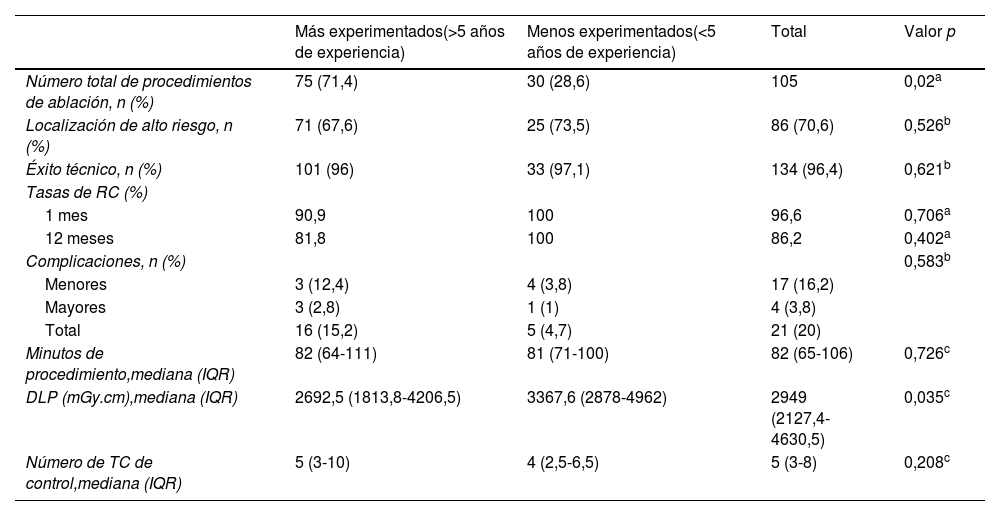Evaluar el éxito técnico, la seguridad y la efectividad de los procedimientos de termoablación (TA) guiados por TC en tumores abdominales, incluyendo carcinomas hepatocelulares (CHC), metástasis hepáticas de cáncer colorrectal (MHCCR) y carcinomas de células renales (CCR), asistidos por un sistema de navegación electromagnética (SNEM), según la experiencia del radiólogo.
Material y métodosSe recopilaron retrospectivamente datos de pacientes sometidos a TA guiada por TC desde 2020 hasta 2022 y se registraron las características de las lesiones. Se consideraron lesiones de alto riesgo aquellas ubicadas en el hígado en región subfrénica, subcapsular o a menos de 1cm del intestino, vía biliar, vena porta principal, vena cava o vesícula biliar, y aquellas ubicadas en el riñón en la valva anterior o cerca de la vía urinaria. Los radiólogos que realizaron los procedimientos fueron clasificados como más o menos experimentados (más o menos de 5 años de experiencia en TA percutánea). El éxito técnico se evaluó inmediatamente tras el tratamiento. Se registraron los datos del procedimiento, las tasas de respuesta y complicaciones.
ResultadosSe trataron 139 tumores en 105 sesiones de ablación en 93 pacientes, 69 hombres y 24 mujeres. El 62% de los tumores fueron CHC, el 27% MHCCR y el 12% CCR. La mediana de tamaño tumoral fue de 16mm. El 68% de los tumores estaban en localizaciones de alto riesgo. El éxito técnico fue del 96,4% y hubo complicaciones menores en el 20% de los procedimientos, y mayores en el 3,8%. La mediana de seguimiento fue de 12 meses. Las tasas de respuesta completa fueron del 96,6%, 93,1% y 86,2% a los 3, 6 y 12 meses, respectivamente. No hubo diferencias significativas en la respuesta al mes (p=0,706) ni al año (p=0,402), complicaciones (p=0,583), tiempo de procedimiento (p=0,729) o número de controles de TC (p=0,208) entre radiólogos más y menos experimentados.
ConclusiónEl SNEM es un dispositivo de asistencia en procedimientos intervencionistas que permite la realización de ablaciones precisas independientemente de la experiencia del radiólogo o la localización de alto riesgo.
To assess the impact of radiologist experience on the technical success, safety and effectiveness of CT-guided thermal ablation (TA) procedures for abdominal tumours, including hepatocellular carcinomas (HCC), colorectal cancer liver metastases (CRLM), and renal cell carcinomas (RCC), when assisted by an electromagnetic navigation system (EMNS).
Material and methodsWe retrospectively collected data for patients who had undergone CT-guided TA between 2020 and 2022, recording the characteristics of the lesions. Lesions were considered high-risk if they were located in the subphrenic or subcapsular areas of the liver or less than 1cm from the bowel, bile duct, portal vein, vena cava or gallbladder and those located in the kidney in the anterior leaflet or close to the urinary tract. The radiologists who performed the procedures were classified according to whether they had more or less experience (more or less than five years of experience in percutaneous TA). Technical success was assessed immediately after treatment. Procedure data, response and complication rates were recorded.
ResultsA total of 139 tumours were treated in 105 ablation sessions in 93 patients, consisting of 69 men and 24 women. Sixty-two percent of the tumours were HCC, 27% were CRLM, and 12% were RCC. The median tumour size was 16mm. A total of 68% of the tumours were located in high-risk areas. The technical success rate was 96.4%, with minor complications occurring in 20% of the procedures and major complications in 3.8%. The median follow-up was 12 months. The complete response rates were 96.6%, 93.1%, and 86.2% at 3, 6, and 12 months, respectively. There were no significant differences in response at one month (p=0.706) or one year (p=0.402), complications (p=0.583), procedure time (p=0.729), or the number of follow-up CT scans (p=0.208) between more and less experienced radiologists.
ConclusionAn EMNS enhances accuracy and standardisation in interventional procedures, enabling precise ablations, regardless of the radiologist's experience or location involved.















